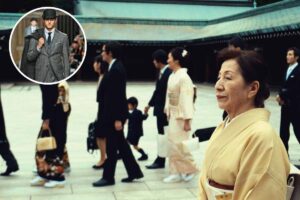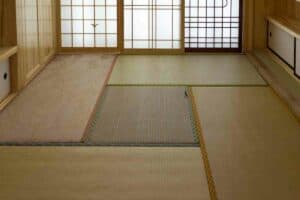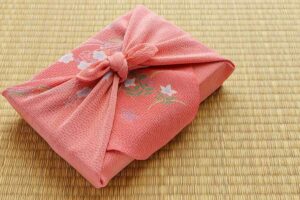In Japan, there is no one-size-fits-all answer to the question of what makes a house a home.
Each region of the country has its own unique style of housing, and even within those regions, there are variations depending on the climate and cultural influences.
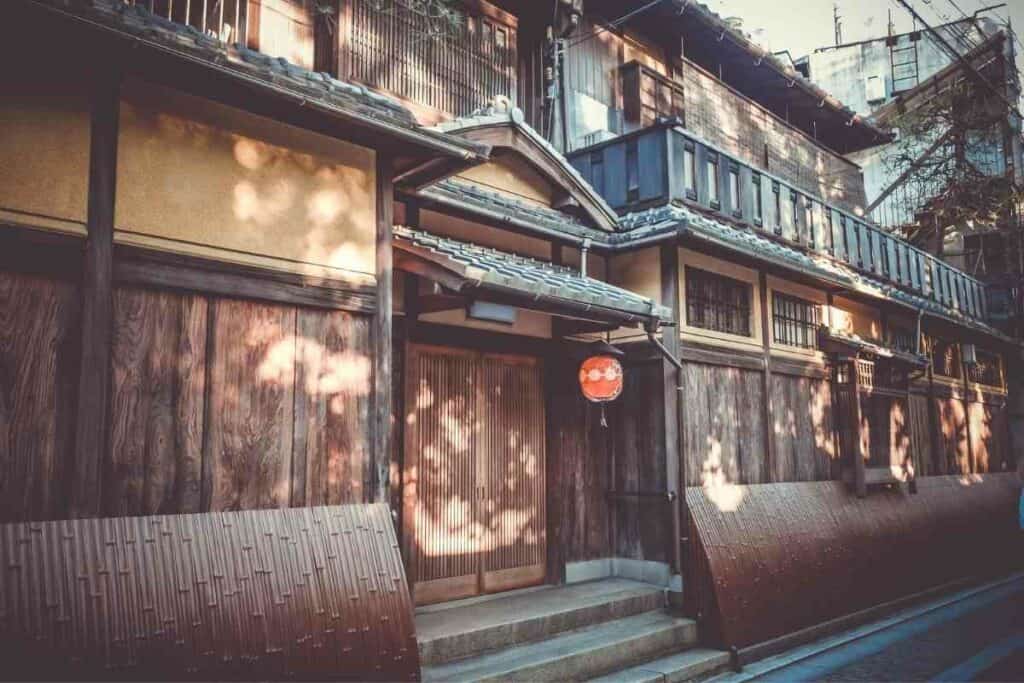
Let’s take a look at 22 traditional Japanese houses and their distinctive styles.
Table of Contents
Different Styles of Traditional Japanese Houses
There are three main styles of houses:
- Minka
- Sukiya
- Shoin
Most of the other styles are a substyle of these three main styles, and most of them will be under the minka style.
1. Minka 民家
Translating to “house of the people”, minka are the traditional Japanese house style.
Farmers, skilled trade workers, merchants, and any other non-samurai class would live in one of these style houses.
They are characterized by their simple rectangular shape and roof type. It is the most common style and can be found all over Japan.
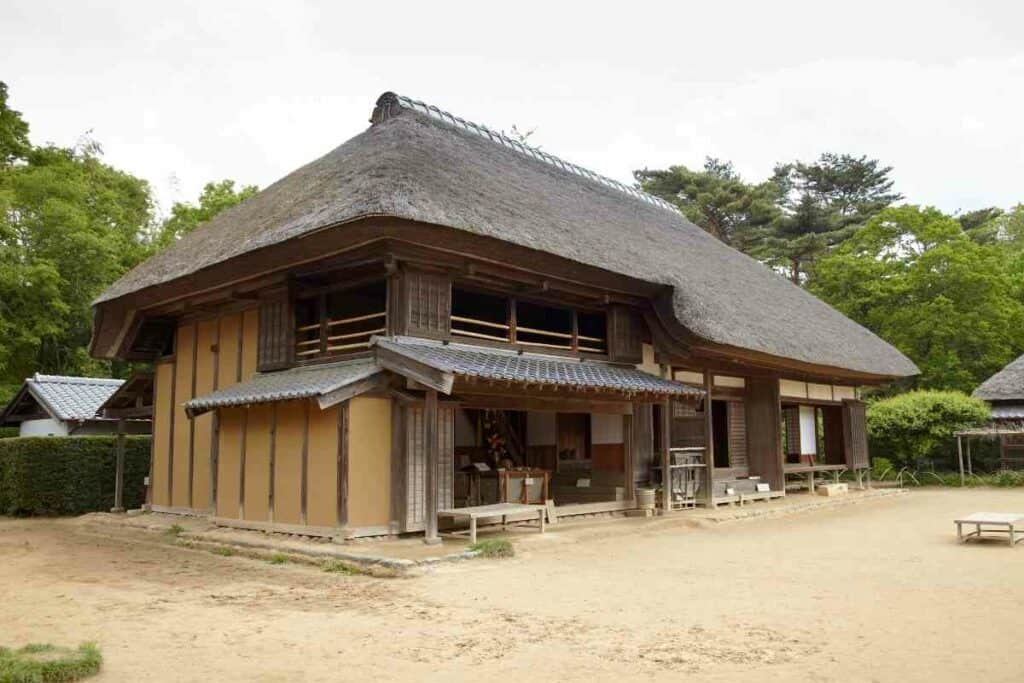
They’re usually made out of wood and have a thatched roof. Minkas are very spacious and have a lot of natural light.
The most common style of home is minka, and different regions of Japan have an effect on the way they are built, and what interiors they have.
Key Takeaway – There are nōka (農家) which are the houses farmers use, gyoka (漁家) where fishermen live, sanka (山家) for homes that are built in the mountains, and traditional homes called machiya (町屋) where most of the tradespeople and merchants live.
2. Sukiya 数寄屋
Sukiya is a more refined and tasteful style of traditional Japanese houses.
Tea ceremonies were often performed in this style house to showcase a higher class and level of sophistication.
Because of this, Sukiya houses are designed to be very clean and elegant, with a minimalistic approach.
Sukiya-style houses are typically small and feature a thatched roof.
They often have an open floor plan, with the living area and kitchen located in the same space. The interior is usually decorated with tatami mats and paper lanterns.
3. Shoin 書院造
Shoin is a style of a traditional Japanese house that was reserved for the military and samurai classes.
The word shoin is derived from the word shoku (書), meaning “to write”, and in (院), meaning “hall” or “room”.
Shoin thus refers to the writing room in a samurai’s residence.
A shoin residence features an omoya (母屋), or the core of the building, surrounded by aisles called hisashi (廂庇).
A shoin residence will also have square support columns and a floor completely covered in tatami.
Support Styles of Traditional Japanese Houses
There are also different post and beam support styles in traditional Japanese houses.
A wide variety of support styles emerged as a way of finding the most structurally sound construction method to withstand the multitude of earthquakes Japan experienced.
4. Inverted U
The “inverted U” style consisted of two vertical posts with a horizontal beam connected at the top.
There would normally be two sets of supports, one at each end of the house.
5. Box
The “box” is similar to the “inverted U”, except instead of two free-standing U shapes, they are connected to each other for more support.
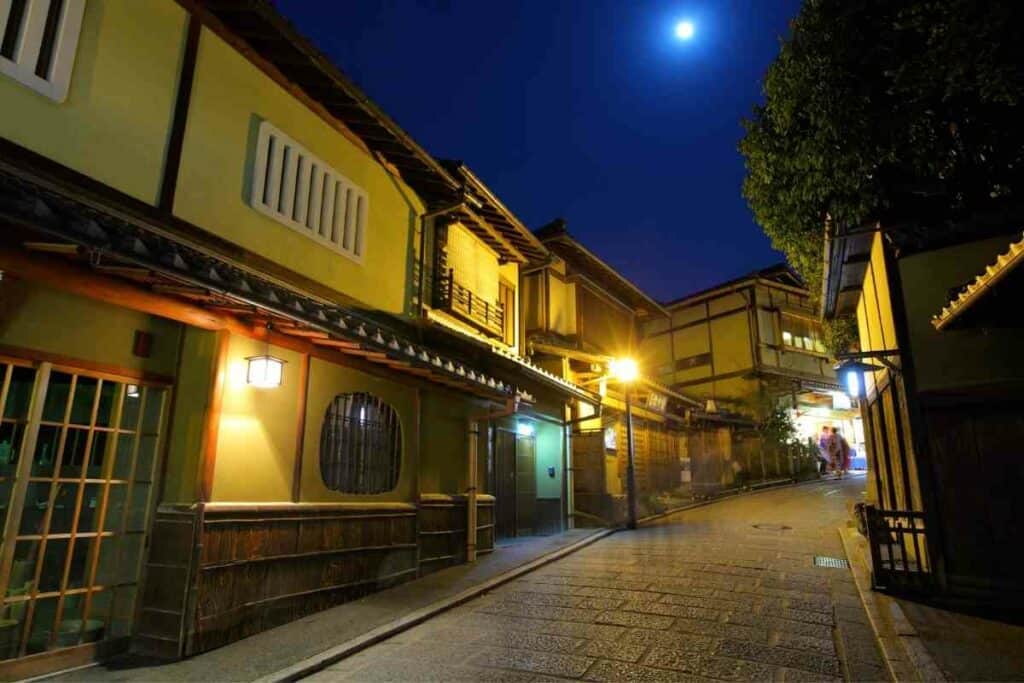
6. Umbrella
The “umbrella” style has one vertical central post in the middle of the house, and 4 horizontal beams that extend outwards from that post.
The beams extend to the corners of the house.
7. Cross
The “cross” was good for much smaller traditional Japanese houses.
This method only used two beams that were fitted together in the middle forming an X, with one vertical post at each end of the beams.
8. Double Cross
The method doubled the two beams and four posts to have four beams and eight posts.
Instead of one X across the ceiling, there would be two Xs side by side to provide the most support in a longer room.
9. Rising Beam
The “rising beam” support method is one of the sturdiest.
These supports are fixed to the tops of posts and vertical beams and rise towards the roof to support it.
As a Result – The triangular shapes that these supports have provide more strength than the right angles typically used in support structures.
Floor Plan Styles of Traditional Japanese Houses
Traditional Japanese houses are also categorized by the floor plan spacing.
The two most common types are kyoma and inakama.
10. Kyoma 京間
Kyoma is a style where rooms are based on the size of a tatami mat.
Tatami mats are twice as long as they are wide, and measure 3 feet by 6 feet.
This means that rooms are built to perfectly fit tatami mats when they are placed side by side and end to end so they don’t need to be cut or altered to fit the room.
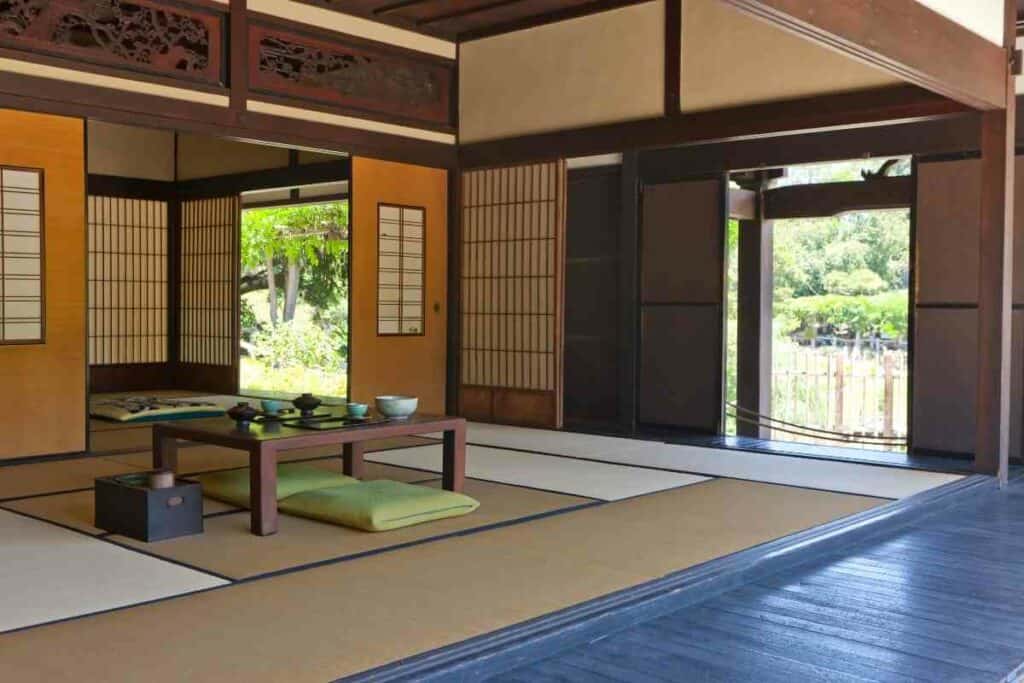
11. Inakama 田舎間
Inakama is a style for houses that feature columns to support the roof instead of walls.
Columns make it a little more difficult to perfectly place tatami mats, but with careful planning, this style makes it a little better.
The distance between the center of one post and the center of the next nearest post will be a factor of 3 feet.
When the tatami mats are arranged, the seam of two parallel tatami mats will line up perfectly in the center of a post, and then just the corners of the mats will need to be cut out to go around the post.
Roof Styles on Traditional Japanese Houses
In the summer, Japan receives plenty of heavy rain, and a steeply sloped roof was necessary to keep the rain out of the houses.
Paired with a rain chain, or a kusaridoi (鎖樋) carried rain off the house and away from the structure.
There are four common roof styles found in traditional Japanese houses.
12. Kirizuma 切妻
Kirizuma is a gabled roof style.
This style roof only has two sides, branching from a ridge in the middle and sloping outwards to cover the walls of the house.
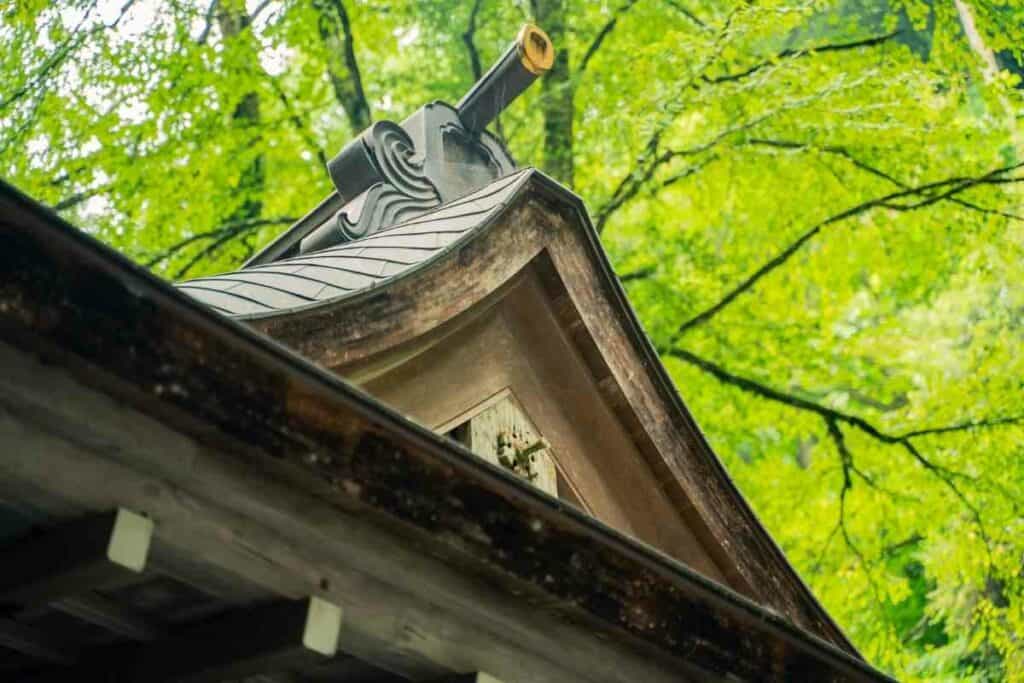
Since the sides are protected from the elements from the slope of the roof, but the front and back are left exposed, this style of roof is made longer to create a shelf over the unprotected walls.
This is the simplest roof type, which also meant less labor and materials and was, therefore, the cheapest.
This style of roof was used for lower-class houses.
13. Yosemune 寄棟
The yosemune style roof is a hipped roof.
A hipped roof is a type of roof in which there are four slopes on the roof that form a ridge at the top.
At the two smaller sides of the house, the roof is made of two triangles that meet at each edge of the ridge, and the longer sides are rectangular and meet at the top of the house forming a ridge where the edges meet.
This roof style is most often seen on Japanese farmhouses but will sometimes be seen in other styles.
14. Irimoya 入母
Irimoya is a complex roof style that combines the kirizuma and yosemune styles forming a hip-and-gable roof.
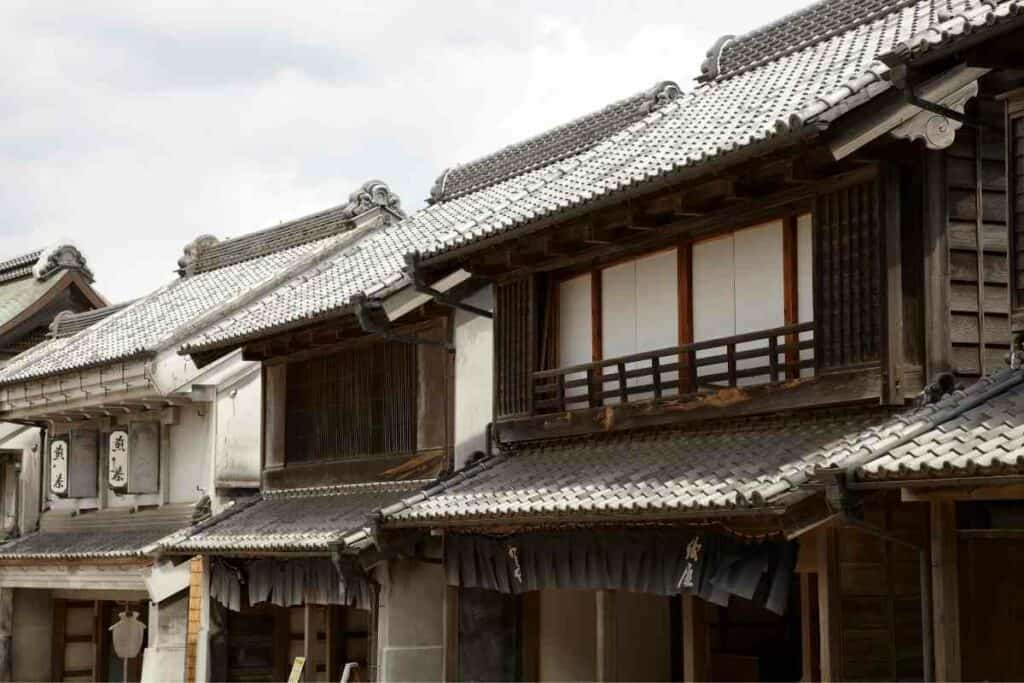
There are two levels to this roof. The very top is the kirizuma, or gabled part, where two sides meet to form a ridge.
The second layer down introduces the yosemune style, which means two additional slopes are added where there weren’t any before.
When thinking of traditional Japanese homes, this style doesn’t often come to mind because it was reserved for high-class families and temples.
Keep In Mind – The amount of work needed to construct this style of roof was much greater and would cost a lot more, but it also provided more support to handle strong winds.
15. Hogyo 兵庫
Hogyo is a square pyramidal roof style.
It’s similar to the yosemune style, since there are four slopes, except the slopes of the hogyo roof meet at a point.
Each side of the room is a triangle shape, which is how the tops can meet at a point, but the roof isn’t nearly as tall as the other styles, making it a much smaller slope.
This roof was best in areas that didn’t receive snow since the slope wasn’t enough to keep it from piling on the roof.
Also Read ?
Interior Elements in Tradition Japanese Houses
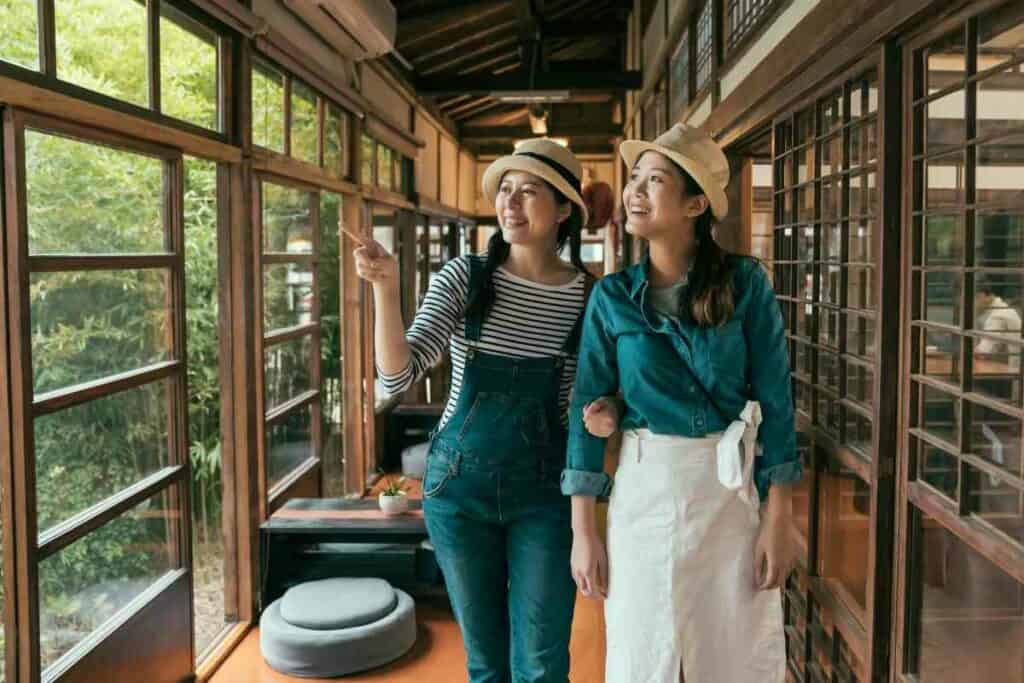
There are common elements in the interior of traditional Japanese houses from building materials to room dividers, and even special areas in the house.
16. Wood
The most common material used in traditional Japanese houses was wood.
Wood is easy to find, and because of the humid climate, it’s also less likely to rot.
There are three main types of wood used in traditional Japanese houses.
- Kiri (桐): Paulownia wood was the most popular type of wood used in traditional Japanese houses. It’s a light wood, so it was easy to work with, and because it’s light, it was also less expensive.
- Kaya (茅): Thatched rice straw was another type of material used for traditional Japanese houses. It was most often seen in the poorer homes because it was the cheapest option.
- Sugi (杉): Cedar wood was the most expensive and therefore was only seen in the houses of the wealthier families. It’s a very durable wood, so it lasted longer, but it was also very heavy, making it difficult to work with.
17. Tatami 畳
Tatami are straw mats that are used as flooring in traditional Japanese houses.
They’re made of rush grass that is woven together and then covered with a layer of fabric.
Tatami was first introduced to Japan in the Heian period, and they became popular in upper-class homes because only they could afford them.
In the Edo period, tatami became more common in lower-class homes as well.
The size of a tatami mat is about 180cm by 90cm, and the thickness is about 5-6cm.
Tatami mats are often used as room dividers because they can be easily moved and stacked on top of each other.
18. Fusuma 襖 and Shōji 障子
Fusuma are wooden sliding doors that often separate one room from another in a traditional Japanese house.
They are made with wooden frames but paper screens.
Shoji are thin, translucent paper screens that also serve as windows.
These are placed in doorways or in between rooms and can be moved around depending on how much privacy is needed.
19. Engawa 縁側
Engawa are verandas that are built around the perimeter of a traditional Japanese house.
They’re usually about 30cm wide, and they act as a transition space between the exterior and interior of the house.
Engawa are also used as storage space or as an extra room for guests to sleep in.
In the Summer – Engawa are often used as a place to cool off because they’re shaded by the eaves of the roof.
20. Genkan 玄関
Genkan are entryways to a traditional Japanese house.
They’re usually located on the engawa, and they act as a transition space between the exterior and interior of the house.
In genkan, you take off your shoes before entering the house so that you don’t track dirt inside.
There’s also often a small shelf or closet in genkan where you can store your shoes.
21. Ranma 欄間
Ranma are wooden beams that are placed between the ceiling and the floor.
They act as support beams, but they also create a sense of separation between rooms.
Ranma are often decorated with carvings or paintings, and they can be made of different types of wood depending on the style of the house.
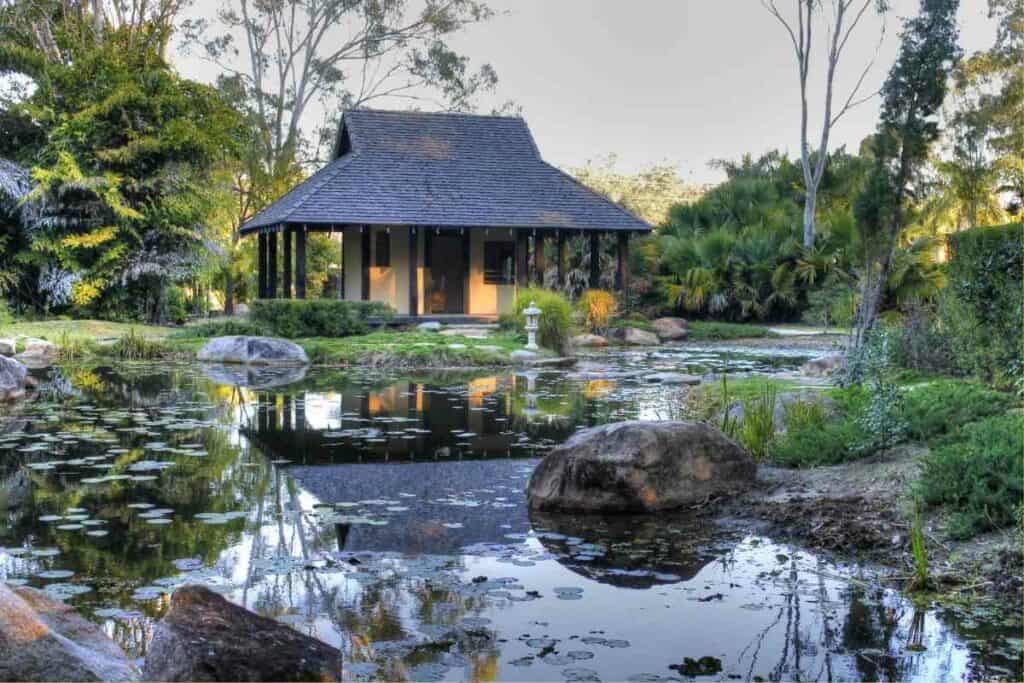
22. Irori 囲炉裏
Irori are sunken hearths that are often found in the center of a traditional Japanese house.
They were originally used for cooking and heating, but now they’re mostly used for decoration.
Irori are usually made of stone or clay, and they’re surrounded by a wooden frame.
The frame is generally decorated with carvings or paintings, and the irori can be used for cooking or heating.
Final Thoughts
Traditional Japanese houses are fascinating structures that have been around for centuries.
Their unique designs and features make them a popular tourist attraction, and they continue to be an important part of Japanese culture today.
There is much history in each of these buildings from the different roof styles, floor plans, regions, and standard elements found in traditional Japanese houses.
Also Useful
- Best Japanese Knives Top Picks for Every Kitchen
- Japan’s Bold New Trend: Dressing Like a British Gentleman (or at Least Trying)
- 7 Best Japanese Sunscreen Products You Can Buy Online
- 5 Best Japanese Makeup Brushes for a Flawless Finish
- 7 Benefits Of Tatami Mats You Should Know
- The Best Furoshiki Wrapping Cloths: Inspiration, Ideas & Cloths You Can Buy


